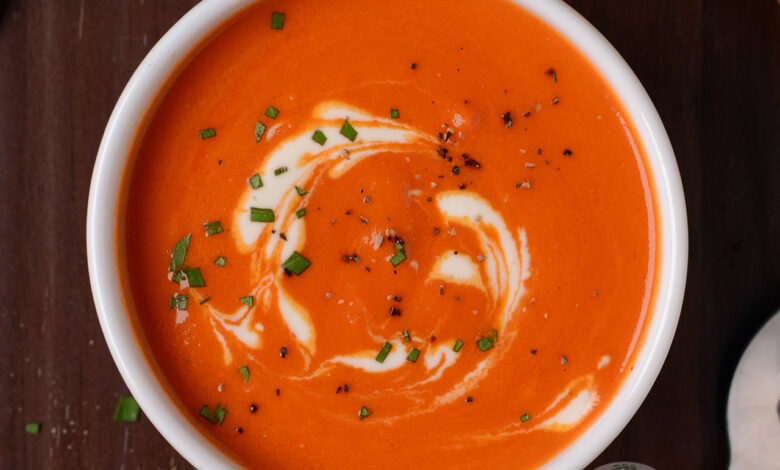Tomato Soup Recipe
Tomato Soup Recipe

Tomato Soup Recipe Introduction:
Tomato soup is a classic comfort food loved for its rich, tangy flavor and creamy texture. This versatile dish can be enjoyed on its own or paired with grilled cheese sandwiches for a nostalgic meal. Made primarily with ripe tomatoes, onions, and aromatic herbs, it’s not only delicious but also simple to prepare. Whether you prefer a smooth and creamy version or a chunky style filled with vegetables, tomato soup can be customized to your taste. Perfect for a cozy evening, it’s a healthy option that warms you from the inside out. Let’s dive into this easy and satisfying recipe!
:max_bytes(150000):strip_icc()/277311spicy-fresh-tomato-soupFranceC4x3-56454ad082214f33960f62665fc8c169.jpg)
Tomato Soup Recipe Introduction:
Tomato soup is a classic comfort food enjoyed around the world for its rich, tangy, and savory flavors. Whether served as a light appetizer or as a meal with a side of grilled cheese, this easy-to-make soup is perfect for any occasion. The natural sweetness of ripe tomatoes combined with herbs and seasonings creates a heartwarming dish that’s both delicious and nourishing.
Recipe Overview:
This tomato soup recipe is made using fresh or canned tomatoes, cooked with onions, garlic, and herbs for depth of flavor. Blended to a smooth consistency, the soup is then finished with a touch of cream or milk for a rich, velvety texture. It’s simple, quick, and can be customized to your taste with different herbs, spices, or add-ins like croutons or cheese. This recipe can be made on the stovetop or in a pressure cooker, and it’s ideal for cozy nights or as an accompaniment to your favorite meal.
Recipe Ingredients:
4 large ripe tomatoes (or 2 cans of whole tomatoes, 14 oz each)
1 medium onion, finely chopped
2-3 cloves garlic, minced
1 tablespoon olive oil or butter
1 teaspoon dried basil or fresh basil (optional)
1 teaspoon sugar (optional, to balance acidity)
2 cups vegetable or chicken broth
1/2 cup heavy cream or milk (optional, for creaminess)
Salt and pepper to taste
Fresh basil leaves for garnish (optional)
Recipe Instructions:
Prepare the Tomatoes:
If using fresh tomatoes, blanch them in boiling water for 2 minutes, then transfer them to ice water. Peel off the skins, remove the seeds (optional), and chop the flesh. If using canned tomatoes, you can skip this step.
Cook the Aromatics:
Heat the olive oil or butter in a large pot over medium heat. Add the chopped onions and sauté for about 5-7 minutes until softened and slightly golden.
Add the garlic and cook for another 1-2 minutes, stirring constantly to avoid burning.
Cook the Tomatoes:
Add the chopped tomatoes to the pot and cook for 10 minutes, stirring occasionally, until the tomatoes break down and soften.
Add the Broth and Simmer:
Add the vegetable or chicken broth to the pot, along with dried basil, salt, pepper, and sugar (if using). Bring the mixture to a simmer and cook for 15-20 minutes to allow the flavors to meld together.
Blend the Soup:
Use an immersion blender directly in the pot to blend the soup until smooth and creamy. Alternatively, you can blend the soup in batches in a regular blender. Be cautious when blending hot liquids.
Finish the Soup:
Once blended, return the soup to the pot if needed and heat it over low heat. Stir in the cream or milk (if using) to add richness and adjust seasoning to taste.
Serve:
Ladle the soup into bowls and garnish with fresh basil leaves if desired. Serve hot.
Recipe Variations:
Spicy Tomato Soup: Add a pinch of red pepper flakes or a chopped fresh chili along with the garlic for a spicy kick.
Roasted Tomato Soup: Roast the tomatoes in the oven before blending for a smoky flavor. Simply halve the tomatoes, drizzle with olive oil, and roast at 400°F (200°C) for 25-30 minutes.
Tomato and Basil Soup: Add a handful of fresh basil leaves during the cooking process for a fresh herb flavor. Garnish with more basil when serving.
Vegan Tomato Soup: Skip the cream and use coconut milk or a plant-based milk for a dairy-free version of this soup.
Presentation and Serving Suggestions:
Serve the tomato soup with a side of crispy croutons or a grilled cheese sandwich for a classic pairing.
Garnish with fresh herbs, such as basil or parsley, and a drizzle of olive oil or a swirl of cream for an elegant touch.
For added richness, top with shredded cheese like cheddar or Parmesan.
Nutritional Information (Per Serving, Approximate):
Calories: 150-200
Protein: 3g
Carbohydrates: 25g
Fat: 7g
Fiber: 4g
Sodium: 800mg (may vary depending on the broth used)
Sugars: 8g
Recipe Conclusion:
Tomato soup is a beloved, comforting dish that is simple to make and packed with flavor. Whether you enjoy it as a starter, a light meal, or paired with your favorite sandwich, this soup is both nutritious and satisfying. You can easily adjust the recipe to suit your preferences, whether you like it spicy, creamy, or full of fresh herbs. It’s a timeless classic that will warm you up on even the coldest of days. Enjoy this delicious bowl of homemade tomato soup!





